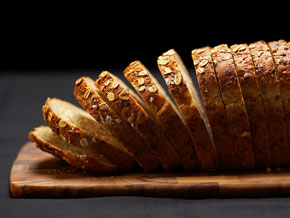Behold! The Health Benefits of Whole Wheat Bread

Photo: © 2009 Jupiterimages Corporation
The benefits of 100 percent whole grains are piling up fast—and so are the number of products touting whole grains on their labels. The trouble? Labels don't always present an accurate picture of what's inside, and the product that appears to be good for you on the label may have all the nutritional goodness of a gum wrapper.
Why do you want whole grains? They contain the bran and the germ of the grain, which have more nutrients than the endosperm—those are the real names; we didn't make them up—that you get with refined or enriched grains. Whole grains are absorbed more slowly than foods made from enriched or bleached flour, so they raise glucose and insulin levels less and keep you feeling fuller longer.
A diet rich in whole grains may also help steer you around cardiovascular disease, metabolic syndrome, even gum disease—not to mention the pain of having to buy bigger pants.
But not all foods that tout whole grain or whole wheat provide it in the healthiest form. You want the grain to have all of its original components. Here are a few fake-out label words to watch for:
The breakfast bread that can control afternoon appetite
Why do you want whole grains? They contain the bran and the germ of the grain, which have more nutrients than the endosperm—those are the real names; we didn't make them up—that you get with refined or enriched grains. Whole grains are absorbed more slowly than foods made from enriched or bleached flour, so they raise glucose and insulin levels less and keep you feeling fuller longer.
A diet rich in whole grains may also help steer you around cardiovascular disease, metabolic syndrome, even gum disease—not to mention the pain of having to buy bigger pants.
But not all foods that tout whole grain or whole wheat provide it in the healthiest form. You want the grain to have all of its original components. Here are a few fake-out label words to watch for:
- Made with whole grains.
It may have a pinch of whole grains, but unless it's 100 percent, you won't reap most of the potential benefits. - Multigrain
This tells you nothing about whether the grains are whole or refined. Even if you're getting 38 different grains, that isn't much good if they are all refined. - Whole grain
If the label doesn't say "100 percent whole grain," it may have many grain blends. Bad words to see paired with "flour" are: "enriched," "bleached," "unbleached," "semolina," "durum" and "rice."
The breakfast bread that can control afternoon appetite
Research suggests that eating rye bread may do an even better job than wheat bread at keeping stomachs from growling later in the day.
In a study, people who ate rye bread with breakfast were less hungry before and after lunch compared with people who ate wheat. Rye's super-high fiber content probably has something to do with it. But researchers suspect that rye may also produce a lower insulin response than wheat bread (this would help with hunger) and that rye may have a unique fiber composition that keeps people feeling full longer.
Of all the rye breads tested, rye-bran bread had the best effect on hunger. Makes sense, since it also has the highest fiber content of the breads.
Four bread brands worth searching for
In a study, people who ate rye bread with breakfast were less hungry before and after lunch compared with people who ate wheat. Rye's super-high fiber content probably has something to do with it. But researchers suspect that rye may also produce a lower insulin response than wheat bread (this would help with hunger) and that rye may have a unique fiber composition that keeps people feeling full longer.
Of all the rye breads tested, rye-bran bread had the best effect on hunger. Makes sense, since it also has the highest fiber content of the breads.
Four bread brands worth searching for
If you've taken a walk down the bread aisle lately, you know what a wall of bread looks like. Who has time to read every label for the best fiber deal?
So don't. Before you head to your local health food store, check out this list of some of the best low-calorie, high-fiber bread options on the market today—brand names included.
A high-fiber diet boasts a whole lot of health benefits, write Dr. Steven G. Pratt and Kathy Matthews in their book SuperFoods HealthStyle. That's because foods packed with fiber tend to brim with disease-fighting phytonutrients.
Here are Pratt and Matthews' top choices for breads that are high in fiber and nutrients, yet calorically moderate.
So don't. Before you head to your local health food store, check out this list of some of the best low-calorie, high-fiber bread options on the market today—brand names included.
A high-fiber diet boasts a whole lot of health benefits, write Dr. Steven G. Pratt and Kathy Matthews in their book SuperFoods HealthStyle. That's because foods packed with fiber tend to brim with disease-fighting phytonutrients.
Here are Pratt and Matthews' top choices for breads that are high in fiber and nutrients, yet calorically moderate.
- Manna from Heaven (Julian Bakery): 8 grams fiber, 85 calories per slice
- Healthseed Spelt (French Meadow Bakery): 4 grams fiber, 81 calories per slice
- Vogel's Soy & Flaxseed Bread (Schwebel's): 3 grams fiber, 100 calories per slice
- The Original Bran for Life Bread (Food for Life Baking Company): 5 grams fiber, 80 calories per slice
Keep Reading






